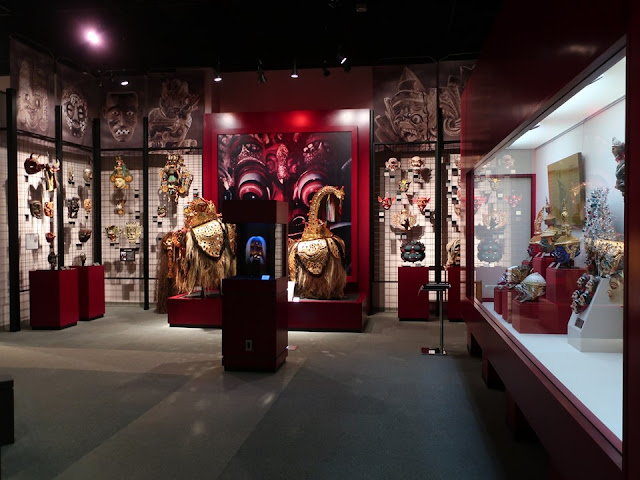What
is “Oni” ?
If
you look up “Oni” in a
Japanese-English dictionary, it is translated as “demon” or “ogre”. However,
it is not correct.
Some
are bad (demons/ogres) like Oni in “Demon Slayer” (Kimetsu-no-Yaiba, Movie). However, many of them help
people and they are enshrined.
This city
museum in northern Japan shows us what is Oni for Japanese with
understandable display.
「鬼滅の刃」で、鬼が注目されましたが、ここでは、様々な日本の鬼を四つに分類するなど、とても分かりやすい展示で、日本人にとって鬼は何なのかを考えさせてくれます。
The building is large enough as “Oni” themed museum.
鬼に絞った展示ですが、大きな施設です。
In front of the permanent exhibition room, there is “Oni-do” which is a trap to capture Oni. It is mentioned in a local folklore in Kitakami area.
常設展示室の前には、鬼を捕まえる罠「鬼ど」があります。北上地方の昔話を元に、漁具と同じく、入ると出られない構造にしています。
Oni-kenbai is a traditional Oni-themed dance in Iwate prefecture where the museum is. Dancers wear Oni masks and swords.
当地の民俗芸能・鬼剣舞(おにけんばい)。鬼の面を付け、剣を持って舞います。
In the exhibition room, we see a short movie at first. Its last message is “Did you see Oni?”
展示室に入ると、まずは、映像展示。「鬼を見たか」で締められます。
At the center of the large exhibition room, Ki (Oni) mon (gate or entrance), which every Japanese is aware of and dislikes, is explained. Kimon is in the north-east of our buildings and towns. It is based on the theory of Yin-Yang and the five elements. Kaneiji temple in Ueno was built at the Kimon of Edo castle, which is a palace now, in order to prevent Oni from entering into.
展示スペースは広いですね。手前は、鬼門の位置のモニュメント。陰陽五行では、北は「生命が死ぬ冬」、東は「生命が誕生する春」と考えられています。命がよみがえる北東が「鬼が出入りする鬼門」とされました。
Oni are categorized into four groups: Oobito (giant), Kishin (Oni god), Gaki (Oni in Buddhism) and Youkai (Japanese folk monster).
鬼を、①大人(おおびと)、②鬼神、③餓鬼、④妖怪、の四つに分類し、鬼曼荼羅として展示しています。崇められる鬼も多く、嫌われてばかりではありせん。
(1) Oobito、大人(おおびと)の鬼
Natural phenomena (thunder etc.) and so on is deified and becomes a giant Oni. The mask in the center is “Yagorou-don” in Kagoshima prefecture.
中央は鹿児島の弥五郎どん。自然現象などを神格化し、巨大化した鬼です。
(2) Kishin、鬼神とされる鬼
Kishin are shown in Shinto rituals, roof tiles at the entrance and so on. They protect people from disasters.
神楽などに登場する鬼神や鬼瓦など、神として人を守ります。悪鬼を鎮める鬼剣舞も鬼神の分類になります。
(3) Gaki、餓鬼
Some Gaki served Buddha, but others were punished by him. Those are Oni in Buddhism.
仏に仕えた、或いは、仏に懲らしめられた鬼です。中央は天邪鬼です。
(4) Youkai、妖怪の鬼
They are written in folktales mainly. The doll in center is Kappa. I think they are likeable Oni because people cooperate with them in some stories.
Reference: “Yo-kai Watch”(video game), “GeGeGe no Kitaro”(manga), “Amabie”(folklore) and so on.
神としての権威を失い怪物と化した鬼と説明されています。でも、多くの妖怪は人から嫌われていと思います。中央はカッパです。
“Oni” festivals in Japan、日本の鬼祭り
Fifty-two festivals are listed. More festivals are held in Shinto shrines than in Buddhist temples.
52件紹介されています。神社の祭りがお寺よりも多いですね。
In Kagoshima prefecture which is located at southern Japan, Oni appear in the New Year’s rite which is held to attain peace and rich-harvest. Oni are violent and they have wooden bars and hit spectators. The people who are hit by Oni are ensured to be healthy. People bring the white paper pieces to their home, because those are talismans to drive bad fortune away. Oni help us; it’s a joyful event.
鹿児島県末吉町では、国家安泰・五穀豊穣を願う正月行事で鬼が登場します。樫の棒で観衆をたたきながら暴れますが、叩かれた人は無病息災、更に、鬼が纏っている御幣は厄除けになります。なまはげの藁と同じですね。鬼は人々の味方、楽しい行事です。
Masks of Oni、鬼の面
Foreign masks are exhibited, too. 海外の鬼の面も展示されています。
New Year’s Oni、春来る鬼
Oni visit villages in New Year at various places across Japan. “Namahage” is the most famous one.
正月に鬼の装束を着けた人が家々を廻る行事、いわゆる来訪神の行事ですね。なまはげが有名ですが、日本各地にあります。
The photo above is Oni in Kagoshima prefecture. Oni motivate children, point out their shortcoming and educate them. The boy is very obedient and adorable.
鹿児島のトシドン。子供と対話しながら、よいところを褒めて励まし、わるいところを指摘し、直すこと約束をさせます。子供が神妙にしていて偉い!
The girl treats “Amahage” (Oni) with sake (alcohol); her father looks happy. Oni is also our companion in Yamagata prefecture (northern Japan).
山形のアマハゲ。子供がお酌しているのが、偉い! 父さんは楽しそう。ここでも鬼は人間の味方です。
Oni-kenbai、鬼剣舞(おにけんばい)
The photo above is the scroll of performance secrets which is written in 1732. People had kept the prideful tradition for a long time. Btw, its shape looks like the one of secrets of Ninja which I saw in a manga.
秘伝書があります。大切に舞って来たのですねえ。皆さんの誇りだと思います。巻物が、子どもの頃に見た忍術の秘伝書のイメージそのものです。誰しもが手にしたいはず。
There are more than 120 groups which play Oni-kenbai.
岩手県には、120を超えるの鬼剣舞団体があるそうです。
Oni in this prefecture、岩手の鬼
In Kuroishi temple, two seven-year-old boys play the role of Oni-Ko(child), and throw talismans. Naked men compete to get it. Oni bring us fortune even here.
黒石寺の祭では、数え七歳の男子二人が、鬼子として儀礼を行い、その後、裸の男達が鬼子が放つ御符を取り合います。ここでも、鬼は神、人間の味方です。
*千年続いた祭りですが、2024年で歴史を閉じました。住職は担い手(檀家)不足と説明していました。檀家の男の子は一人しかいませんでした(2024年2月追記)。祭りを惜しむ声が多いですが、行事を続けるのは簡単ではないのですね。
In Iwate, there are many legends and folktales about Oni We can hear narrations. I wanted to stay there to listen to all of them.
Oni scold us to live properly. However, they don’t do wrong to us, do they?
鬼の伝説や民話がたくさんあります。音声が流れるので、ずっと聞いていたいぐらい。鬼は人を戒める存在であっても、人に悪いことをする存在ではないですねえ。
This is the final area of the permanent exhibition room. I remember that it says “What is Oni? It is something what you think.”
After seeing exhibits, I reckon Oni support
us and watch us to live properly; it is similar to a strict father.
あらためて、鬼とは、を問うコーナーです。「鬼は何か、それはあなたが思うこと」と書いてあったように思います。
私は、この展示を拝見すると、鬼は我々の味方、我々が緩まないように見守ってくれる頑固親父のように感じました。
The Oni-kenbai was performed in front on the museum. There were no spectators, but it was going to live-stream. It was the time of the covid-19 pandemic.
屋外ステージでは、鬼剣舞の無人ライブと中継が行われていました。(コロナの流行中のため)
Young Oni danced and drove away demons. They were cool!
かっこいい、若き鬼達が悪を払ってくれます。
Visited in November, 2020
Official website: https://www.city.kitakami.iwate.jp/life/soshikikarasagasu/oninoyakata/index.html (in Japanese), accessed in August, 2021
Other Oni themed museum in Kyoto prefecture、京都府大江山の鬼の博物館: Japanese Oni Exchange Museum、日本の鬼の交流博物館
Previous post (Museum in the same city):
Michinoku Folklore Village & Kitakami
City Museum、みちのく民俗村と北上市立博物館
Next post (This
area is famous for producing Wagyu beef):
























Comments
Post a Comment